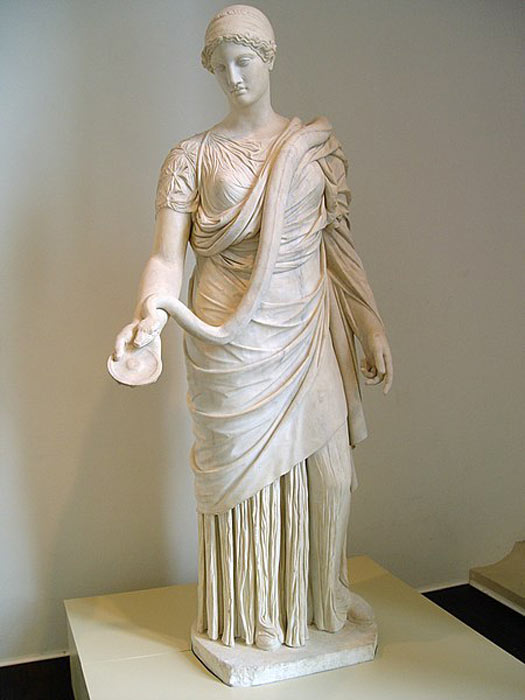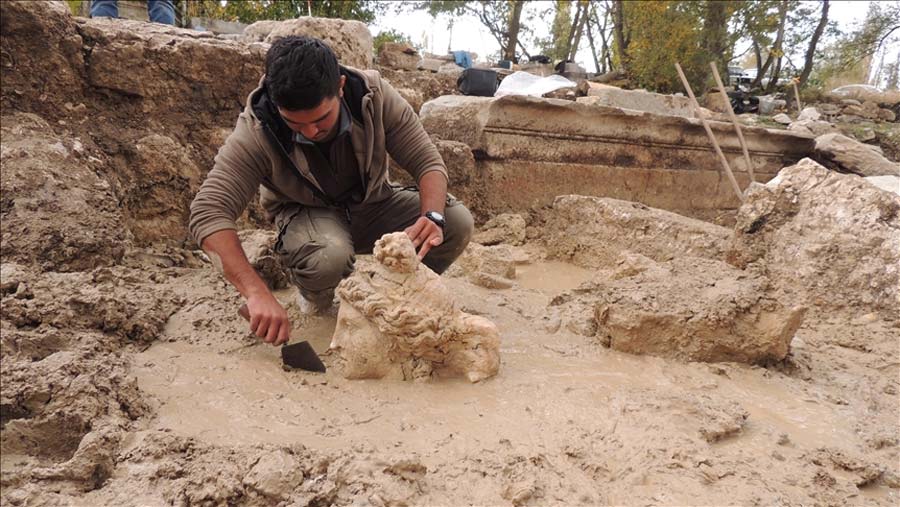Decapitated Statues of Greek Deities Finally Reunited with Their Heads
Excavations at western Anatolia’s ancient Greek city of Aizanoi (also spelt Aezani) continue to unearth stunning artifacts and architectural wonders. The latest in the series of fascinating finds comes in the form of two exceptionally beautiful 5000-year-old Greek statue heads, whose bodies had been found earlier in a different area.
Aizanoi was continuously settled from the Bronze Age till the late seventh century, and then again by the Çavdar Tatars in the 13th century. The site’s excavation coordinator, Gokhan Coskun of Dumlupınar University, is reported by the Greek Herald to have said that the bodies of the statues were found in a previous dig, whilst the heads were unearthed during recent excavations in a creek bed in the ancient city. The heads belong to the Greek goddess of love and beauty, Aphrodite and Greek god of wine, Dionysus.

The partially excavated statue head of the goddess Aphrodite in the ancient city of Aizanoi in Turkey. (Anadolu Agency)
“These are important findings for us, as they show that the polytheistic belief culture of ancient Greece existed for a long time without losing its importance in the Roman era”, Daily Sabah reports Coskun as saying.
- Jug of Priceless Ancient Roman Coins Discovered in Special Turkish City
- The ancient underground city discovered beneath a house in Anatolia
Ancient Aizanoi
Located in what is now Çavdarhisar in the present-day western Anatolian province of Kütahya in Turkey, Aizanoi was home to the Aizanitisians, Phrygians, Greeks, Romans and Byzantines in ancient times. Bronze Age remains have also been found here. Aizanoi made it onto the UNESCO World Heritage Site Tentative List in 2012 with its well-preserved ruins of a spectacular temple of Zeus dating to 3000 BC, an ancient theatre with a 15,000-person capacity, an adjacent stadium that could seat 13,500 people, two baths, the world's first trade stock exchange building, a columned street, five bridges, two agoras (colonnaded market squares), necropolises, and waterways.

The most famous feature at the Aizanoi archaeological site is the Temple of Zeus - the best-preserved temple honoring the Greek god in ancient Anatolia. (ErdalIslak /Adobe Stock)
The ancient city was discovered by European travelers in 1824 and survey work was carried out in the 1830s and 1840s; but excavations only started in 1926 under the aegis of the German Archaeological Institute. They resumed in 1970 and continue to the present. The ongoing excavations are being carried out by a team of 100 workers and 27 technical personnel.
Aizanoi has been described as the second Ephesus of Turkey. Ephesus, which is located on the Ionian coast, is in the Izmir province of Turkey. It was founded by the Greeks in the 10th century BC and subsequently passed to Roman control in 129 BC. A UNESCO World Heritage site, its spectacular ruins are a major tourist attraction.

Ephesus. (muratart /Adobe Stock) Aizanoi has been described as the second Ephesus of Turkey.
Two Bodies Find Their Heads
The bodies of the statues were discovered in previous digs, and Mail Online reports that it is not yet clear how the heads and bodies were separated. Archaeologists involved with the excavations believe that finding the two statue heads suggests that there may have been a sculpture workshop in the area that produced the magnificent statues.
Both heads are carved out of limestone and Aphrodite’s measures 19 inches (48 centimeters) in height while that of Dionysus is 17 inches (43 centimeters). They have been described by the archaeologists as works of art of “astonishing beauty”.

Statue head of the god Dionysus found in the ancient city of Aizanoi in Turkey. (Anadolu Agency)
Was Aizanoi the Site of a Health Cult in Roman Times?
Another significant find by the same team of archaeologists at the site in August this year was a life-size statue of Hygieia, the Greek goddess of health, cleanliness, and sanitation, from whom the word hygiene comes. The statue again had its head missing and so far it remains headless. Archaeologists feel that in this case the head may have been destroyed.
- The Anatolian Histories Part 1: Emerging Empires and Lands Changing Hands
- Astonished Archaeologists Find Roman Colosseum Replica in Anatolia

The Hope Hygieia, 2nd century AD. (CC BY-SA 2.5)
“Unfortunately, (the head) hasn't survived to the present day, but in its current form, we can see that this statue is about the size of a human,” Coskun is quoted by Mail Online to have said. The statue was discovered inside the columned gallery running along the southern part of the agora. Other finds related to Hygieia have been unearthed at the site in the past, leading archaeologists to speculate that Aizanoi may have been home to a Hygieian health cult in Roman times. Coskun says:
“During past digs in Aizanoi, finds related to Hygieia were also found. This situation makes us think that there may have been some construction and buildings related to the health cult in Aizanoi during the Roman era. We're trying to reveal the columned galleries on the west and south wings of the agora (bazaar) and the shops right behind them.”
Continuing excavations at Aizanoi are revealing newer architectural marvels and magnificent sculptures to add to our understanding of this fascinating city that was home to a multiplicity of cultures, some successive and others simultaneous, but each leaving its own distinct imprint.
Top image: An archaeologist unearths the statue head of the goddess Aphrodite in the ancient city of Aizanoi in Turkey. Source: Anadolu Agency
By Sahir Pandey
References
Daily Sabah. 2021. Statue heads of Greek deities found in Turkey’s Aizanoi. Available at: https://www.dailysabah.com/arts/statue-heads-of-greek-deities-found-in-turkeys-aizanoi/news.
Liberatore, S. 2021. Statue heads of ancient Greek deities Aphrodite and Dionysus dating back 5,000 years are unearthed in early Turkish city that was home to one of the world's first stock exchanges. Available at: https://www.dailymail.co.uk/sciencetech/article-10145241/Statue-heads-ancient-Greek-deities-dating-5-000-years-Turkey.html.
The Greek Herald. 2021. Statue heads of Greek gods found in ancient city of Aizanoi in Turkey. Available at: https://greekherald.com.au/culture/statue-heads-greek-gods-found-ancient-turkish-city-aizano/.




















Comments
Hi All,
This is an extraordinary find to say the least an found in Tyre oh sorry Tyre's in The Bible; I meant Anatolia Turkey.
Last year in 2020 I think it was February or March there is a Temple that was uncovered in Anatolia. It was dedicated to the quote god of war. It's a figure of this being was etched in the The Temple Stone.
I think it's name was Ningirsu male this figure may have had another name as well Azazel. This figured appeared to have wing's attached to its body shaped like an butterfly or Moth wing's.
Anatolia is turning in to a regular hot bed of discovery for the Ancient World, in archeology with these deities bodies an heads discovered of these Greek deities.
One question will anyone do any Carbon dating to see how far back these Statues go in Ancient History?
I'm serious about my next question this is not a joke is there an system utilized in archeology or anthropology that could possibly lift Finger Prints from off these Statues?
I would think since they've been buried under Earth for so long perhaps something may have gotten preserved somehow.
That's all I have too share and question at the moment about this exciting discovery in Anatolia, Turkey, so until next discussion Everyone, Goodbye!